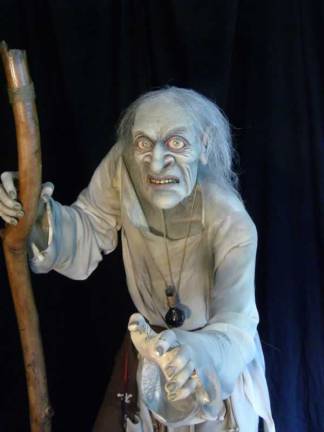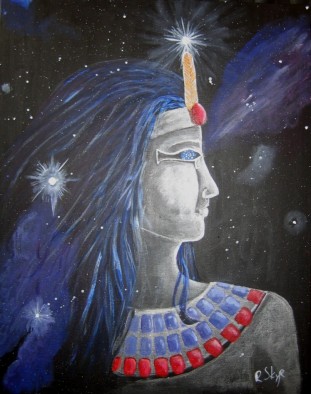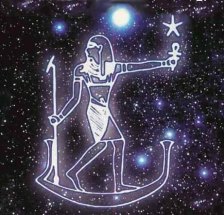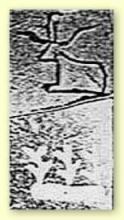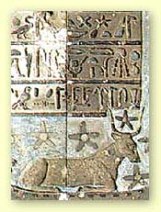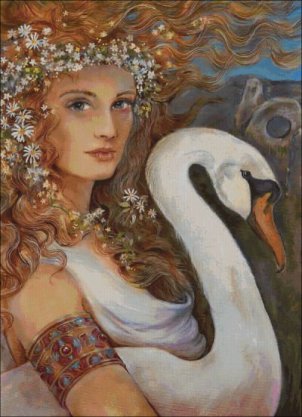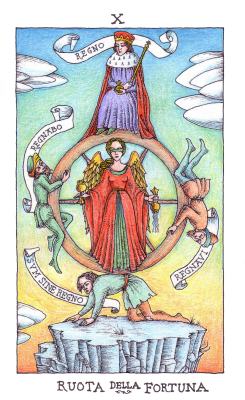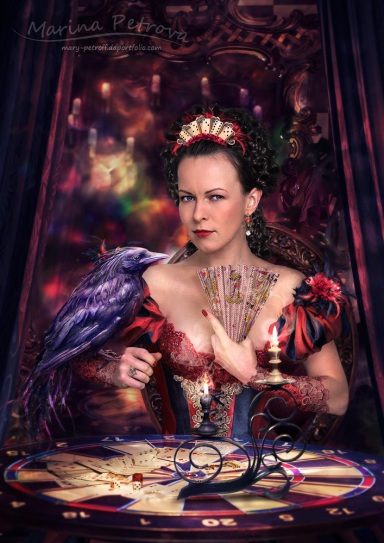
“Isis” by Lisa Iris
“Isis’ themes are magic, harvest, dreams, divination, perspective, faithfulness, love, spirituality and destiny. Her symbols are bloodstones, amethyst, silver, myrrh, hawks and the moon. One of the most complete Goddess figures in history, Isis breathes on us with spring winds to revitalize and fulfil our spirits in every way. Egyptians venerated Isis as the Queen of Sorcery, Life of the Nile, Mother Moon, and Protectress. Isis taught humankind the basic skills necessary to build civilizations, and She came to represent the powerful attributes of faithfulness, love, inner beauty, oracular insight, and spiritual awareness (to name just a few). She could also change Her followers’ destinies.
Today was the Festival of Isis, a spring harvest festival in Egypt, honoring the giver of all life, Isis. Put a bloodstone or amethyst in your pocket today to inspire any or all of Isis’s characteristics in your soul and life. If you have any silver or white clothing, wearing them will also foster Isis-centered energy, because these colors are associated with the moon.
One traditional activity today is fortune-telling, an art under Isis’ dominion. To encourage visionary dreams from Her, put some rose petals under your pillow before going to bed, and burn some myrrh or jasmine incense. Keep a dream diary handy, and write your impressions immediately upon waking so you won’t lose the insight.”
(Patricia Telesco, “365 Goddess: a daily guide to the magic and inspiration of the goddess”.)

“Isis” by Doreen Virtue
“Isis, the Egyptian Goddess of rebirth remains one of the most familiar images of empowered and utter femininity. The Goddess Isis was the first daughter of Geb, god of the Earth, and Nut, the Goddess of the Overarching Sky. Isis was born on the first day between the first years of creation, and was adored by Her human followers.
Unlike the other Egyptian Goddesses, the Goddess Isis spent time among Her people, teaching women how to grind corn and make bread, spin flax and weave cloth, and how to tame men enough to live with them (an art form on which many of us would welcome a refresher course!). She was considered the patron saint of women, mothers and children.
Isis taught Her people the skills of reading and agriculture and was worshipped as the Goddess of medicine and wisdom.
It is told that She managed to trick Re into revealing his secret name to Her and in doing so, Isis obtained many magical powers, making Her a Goddess of magic.
More than any other of the ancient Egyptian Goddesses, Isis embodied the characteristics of all the lesser Goddesses that preceded Her. Isis became the model on which future generations of female deities in other cultures were to be based.
As the personification of the ‘complete female’, Isis was called ‘The One Who Is All’, Isis Panthea (‘Isis the All Goddess’), and the ‘Lady of Ten Thousand Names’.
The Goddess Isis, a moon Goddess, gave birth to Horus, the god of the sun. Together, Isis and Horus created and sustained all life and were the saviors of their people.” [1]
Isis and Osiris

“Isis and Osiris” by Susan Seddon Boulet
“The history of Isis and Osiris, the Egyptian god and Goddess, is known throughout Egypt and has become one of the most popular and fabled folklore tale in Egyptian mythology. Isis was believed to be the daughter of Nut and Geb. The Egyptian Goddess Isis later married Osiris, another ancient Egyptian deity and who was also Her brother. Osiris seems to have been in a continual feud with another Egyptian god, Seth. In many versions of the tale, Osiris and Seth are brothers and Isis and Seth’s wife Nephtys are their sisters as well as their wives. Eventually Seth killed Osiris by drowning him in the Nile. Isis the Goddess of magic used Her powers to bring Her husband back to life only to have him once again struck by Seth.
Apparently determined to accomplish the deed in a way that even Isis would be unable to undo, Seth mutilated Osiris into multiple parts and hid them throughout the desert. Isis would not be bested by Seth and in a somewhat romantic tale, proceeded to spend many years searching for Her husband’s various body parts. The Egyptian Goddess Isis finally managed to find almost all of them and once again used Her magical powers to bring about his rebirth. At this point, it appears She became pregnant, although the manner by which She became impregnated seems to be a subject of much debate. Some traditions state that Isis hid Osiris until he was able to impregnate Her and that Osiris eventually succumbed to death from the wounds inflicted by Seth. Other tales instead contend that Isis actually impregnated Herself with her husband’s body.

“Isis” by Hrana Janto
Whatever the method, The Egyptian Goddess Isis gave birth to a son, Horus, who would achieve significant fame throughout Egypt. In later years, it was recounted that Horus sought to avenge of his father’s murder and proceeded to kill Seth.” [2]
The myths of Isis and Osiris caution us about the need for occasional renewal and reconnection in our relationships. Isis also reminds us to acknowledge and accept the depths of our emotions.
Click here to read more of Her stories at Goddess Gift.
“Unlike many Egyptian gods and Goddesses, Isis remained in the same form from the beginning of Her history to current dates. The Egyptian Goddess Isis achieved much fame throughout history and many temples were dedicated to Her honor and for the purpose of worshipping Her.
The Egyptian Goddess Isis played an important role in the development of modern religions, although Her influence has been largely forgotten.
The festivities surrounding the flooding of the Nile each year, originally named ‘The Night of the Tear-Drop’ in remembrance of the extent of the Isis’ lamentation of the death of Osiris, Her tears so plentiful they caused the Nile to overflow, is now celebrated annually by Egyptian Muslims and is called ‘The Night of the Drop’.
She was worshipped throughout the Greco-Roman world. During the fourth century when Christianity was making its foothold in the Roman Empire, Her worshippers founded the first Madonna cults in order to keep Her influence alive.
 Some early Christians even called themselves Pastophori, meaning the shepherds or servants of Isis. . . which may be where the word ‘pastors’ originated. The influence of Isis is still seen in the Christian icons of the faithful wife and loving mother.
Some early Christians even called themselves Pastophori, meaning the shepherds or servants of Isis. . . which may be where the word ‘pastors’ originated. The influence of Isis is still seen in the Christian icons of the faithful wife and loving mother.
Indeed, the ancient images of Isis nursing the infant Horus inspired the style of portraits of mother and child for centuries, including those of the ‘Madonna and Child’ found in religious art.
The power of the Goddess Isis in the ‘public arena’ was also profound. Her role as a guide to the Underworld, was often portrayed with winged arms outstretched in a protective position. The image of the wings of Isis was incorporated into the Egyptian throne on which the pharaohs would sit, the wings of Isis protecting them.
The ancient Egyptian Goddess Isis has many gifts to share with modern women. Isis embodies the strengths of the feminine, the capacity to feel deeply about relationships, the act of creation, and the source of sustenance and protection.
At times Isis could be a clever trickster empowered by her feminine wiles rather than Her logic or brute strength. However, it is also the Goddess Isis who shows us how we can use our personal gifts to create the life we desire rather than simply opposing that which we do not like.” [3]

ASSOCIATIONS:
General: Full moon, images of madonna and child, rivers (especially the Nile) and the ocean, hair braids, cattails, papyrus, knots and buckles, stars, the ankh symbol, throne, the rattle, diadem headdress (circular disk with horns), cow, wings, milk, perfume bottles, and March 5 (feast day).
Animals: Sparrowhawk, or kite, crocodile, scorpion, crab, snake (especially cobra), and geese.
Plants: Cedar, corn, tamarisk, flax, wheat, barley, grapes, lotus, balsam, all flowers, trees and all green plants.
Perfumes/Scents: Tamarisk, lotus, balsam, amber oil, cedarwood, sandalwood, cinnamon, and sweet orange.
Gems and Metals: Silver, gold, ebony, ivory, obsidian, lapis lazuli, and scarabs.
Colors: Silver, gold, black, red, cobalt blue, and green. [4]
Sources:
Ancient Egypt Online, “A Biography of the Egyptian Goddess Isis“.
Goddess Gift, “Goddess Symbols: Isis“.
Goddess Gift, “Isis, the Egyptian Goddess of Magic and Giver of Life“.
Suggested Links:
Ashwood, Moonwater. Order of the White Moon, “Isis, Healing Queen“.
Being, Venus. Order of the White Moon, “Isis: The Great Mother“.
Hill, J. Ancient Egypt Online, “Isis“.
Love of the Goddess, “Isis, Mother Goddess of the Universe“.
Ravenwing, Morgana. Order of the White Moon, “Isis: The Universal Goddess“.
Revel, Anita. igoddess.com, “Isis: see it clearly, sister“.
Seawright, Carol. Kunoichi’s Web Page, “Isis“.
Wikipedia, “Isis“.
WolfWinds, Silver. Order of the White Moon, “Isis“.
 “Istustaya’s themes are divination, communication (with the Divine) and destiny. Her symbols are sacred dance, circles, mirrors and thread. In Anatolia this Goddess rules over all matters of fate and is an adept diviner, often using a mirror for descrying so She can share insights into our future. Besides this, She personally weaves the thread of life for each person born, patterning his or her destiny.
“Istustaya’s themes are divination, communication (with the Divine) and destiny. Her symbols are sacred dance, circles, mirrors and thread. In Anatolia this Goddess rules over all matters of fate and is an adept diviner, often using a mirror for descrying so She can share insights into our future. Besides this, She personally weaves the thread of life for each person born, patterning his or her destiny.




